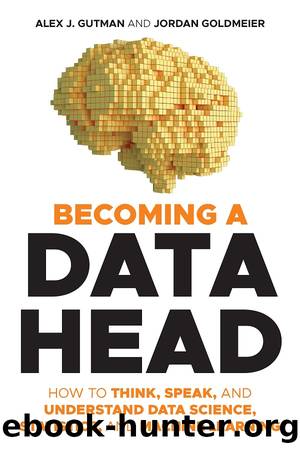Becoming a Data Head: How to Think, Speak, and Understand Data Science, Statistics, and Machine Learning by Alex J. Gutman & Jordan Goldmeier

Author:Alex J. Gutman & Jordan Goldmeier [Gutman, Alex & Goldmeier, Jordan]
Language: eng
Format: epub
Tags: Business & Economics, Information Management, statistics, computers, Data Science, Data Analytics, Information Technology
ISBN: 9781119741718
Google: KCUqEAAAQBAJ
Publisher: John Wiley & Sons
Published: 2021-04-13T00:04:18.838523+00:00
Armed with this list, you'll be able to effectively challenge, understand, and appreciate the statistics you see.
NOTES
1 Don't forget to leave us a review on Amazon.
2 Recall from Chapter 1, a data science project must start with a clear question.
3 We realize 50% is an excellent shooting percentage in basketball. LeBron James, for example, has a career field goal percentage of 50%. So, no, your intern probably can't shoot that well, but 50% makes the math easier to follow. But good for you, being a Data Head and thinking, âWait isn't that overly optimistic?â
4 O'Neil, C., & Schutt, R. (2013). Doing data science: Straight talk from the frontline. O'Reilly Media, Inc.
5 Review Chapter 1 for more on how to interrogate the question itself.
6 We used a two-sided Fisher's exact test.
7 This example would require something called an equivalence test. It's beyond the scope of this chapter but be aware it's out there. Tell your team and use it. If you can follow the logic of this chapter, you can understand an equivalence test.
8 â5 Sigma What's That?â blogs.scientificamerican.com/observations/five-sigmawhats-that
9 There are statistical ways to correct this. Look up the âMultiple Comparisons Problem.â
10 Effect size can take on many meanings in statistics. Here, we're simply talking about effect size as the difference between two numbers.
11 No, we did not actually run this test or collect data.
12 Using the statistical software R: `prop.test(c(65, 50), c(100, 100), alternative = "greater")`
Download
This site does not store any files on its server. We only index and link to content provided by other sites. Please contact the content providers to delete copyright contents if any and email us, we'll remove relevant links or contents immediately.
Zero to IPO: Over $1 Trillion of Actionable Advice from the World's Most Successful Entrepreneurs by Frederic Kerrest(4294)
Machine Learning at Scale with H2O by Gregory Keys | David Whiting(4179)
Never by Ken Follett(3790)
Harry Potter and the Goblet Of Fire by J.K. Rowling(3774)
Ogilvy on Advertising by David Ogilvy(3510)
Shadow of Night by Deborah Harkness(3303)
The Man Who Died Twice by Richard Osman(2997)
Book of Life by Deborah Harkness(2867)
The Tipping Point by Malcolm Gladwell(2827)
Will by Will Smith(2792)
0041152001443424520 .pdf by Unknown(2784)
My Brilliant Friend by Elena Ferrante(2774)
How Proust Can Change Your Life by Alain De Botton(2742)
Purple Hibiscus by Chimamanda Ngozi Adichie(2652)
How to Pay Zero Taxes, 2018 by Jeff A. Schnepper(2602)
Hooked: A Dark, Contemporary Romance (Never After Series) by Emily McIntire(2500)
Rationality by Steven Pinker(2291)
Borders by unknow(2229)
Can't Hurt Me: Master Your Mind and Defy the Odds - Clean Edition by David Goggins(2227)
